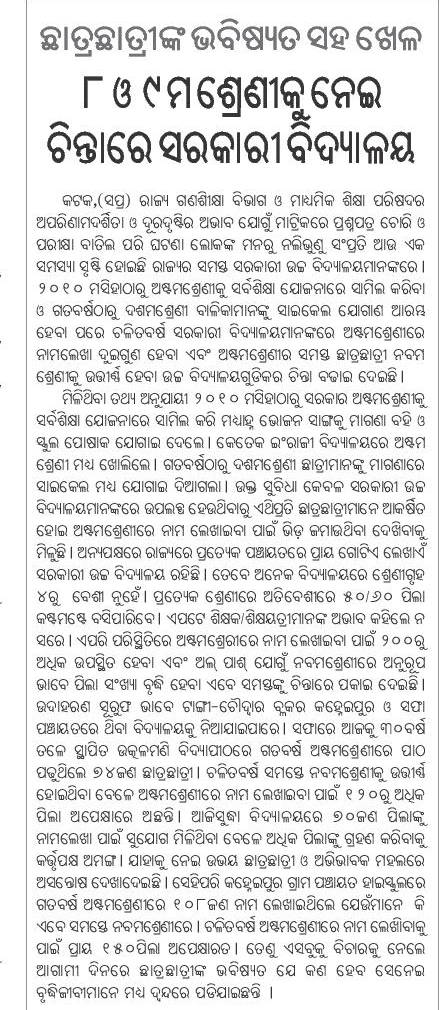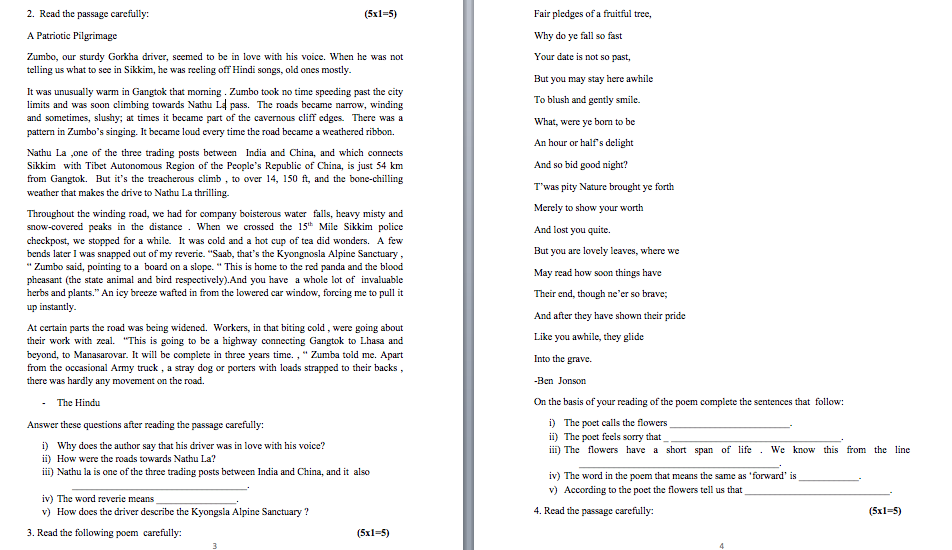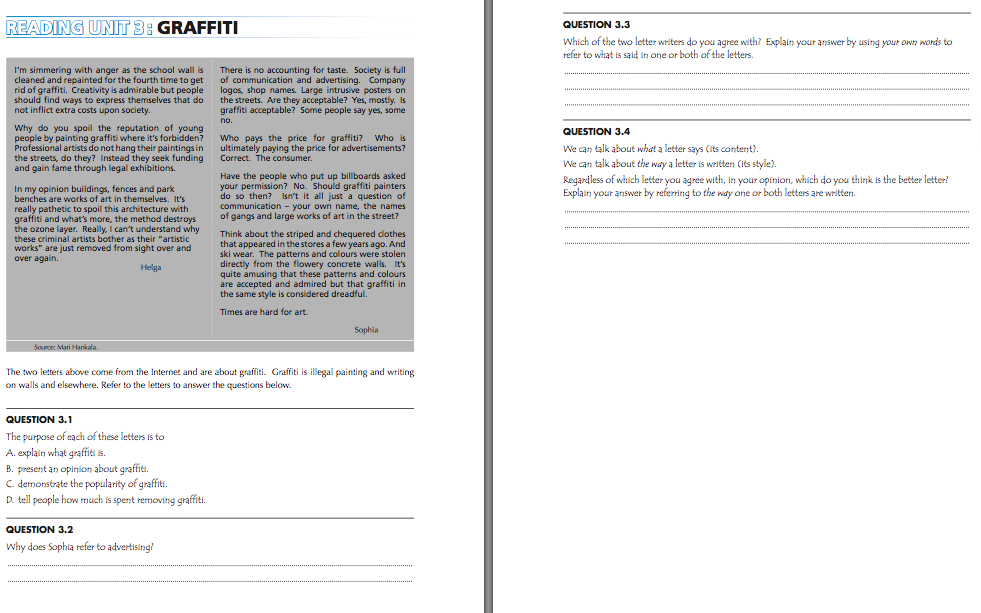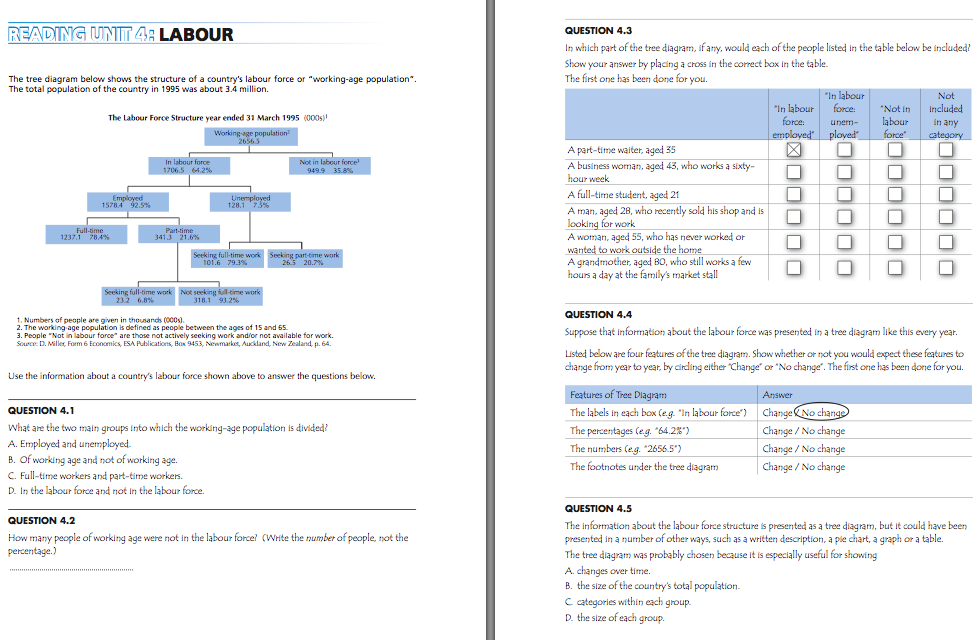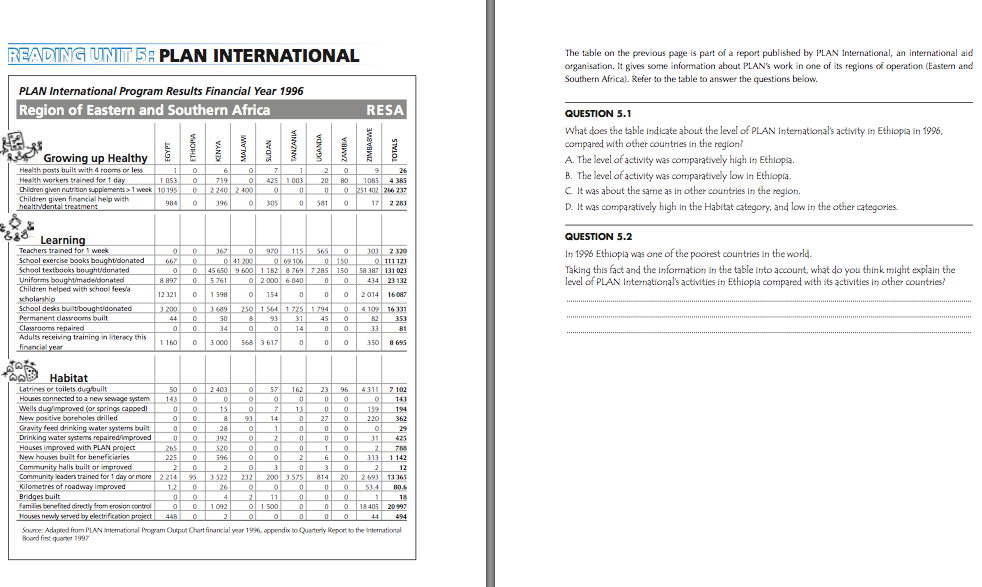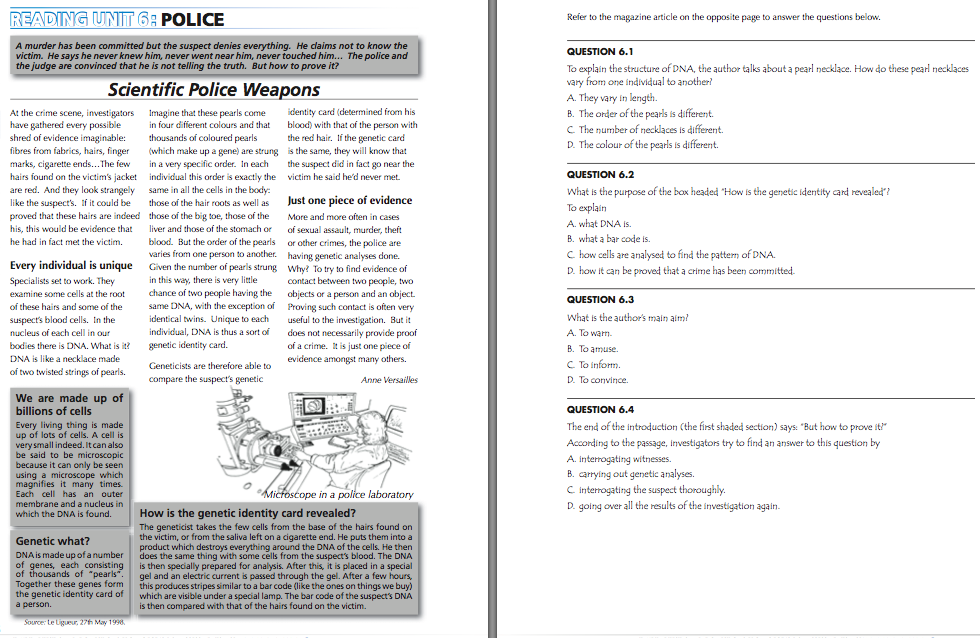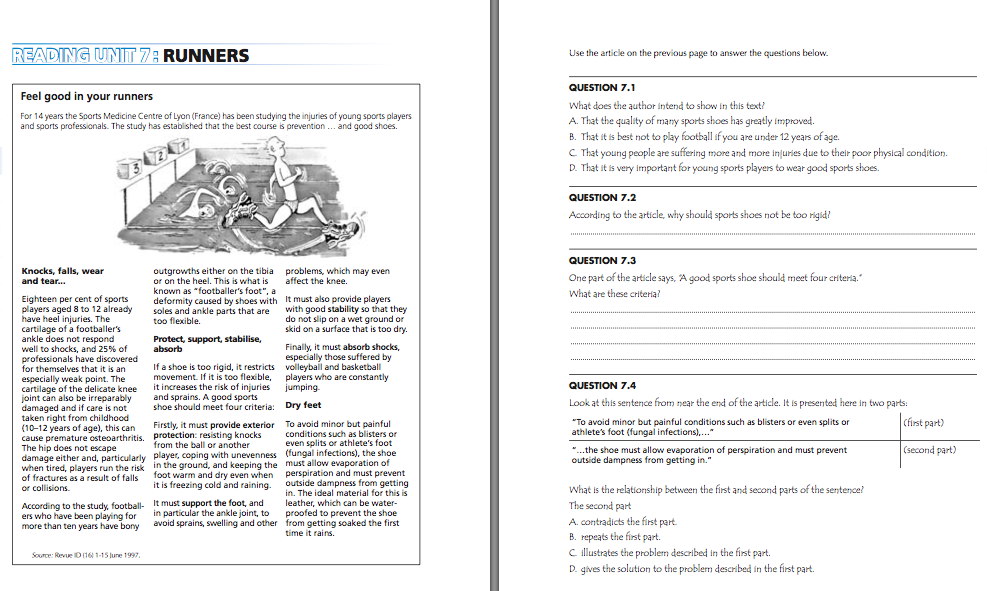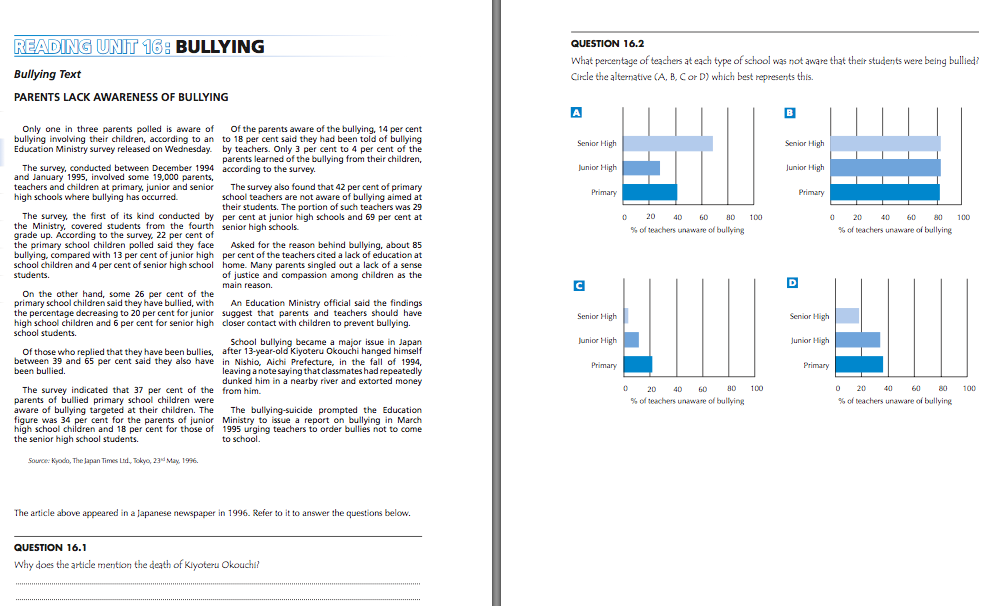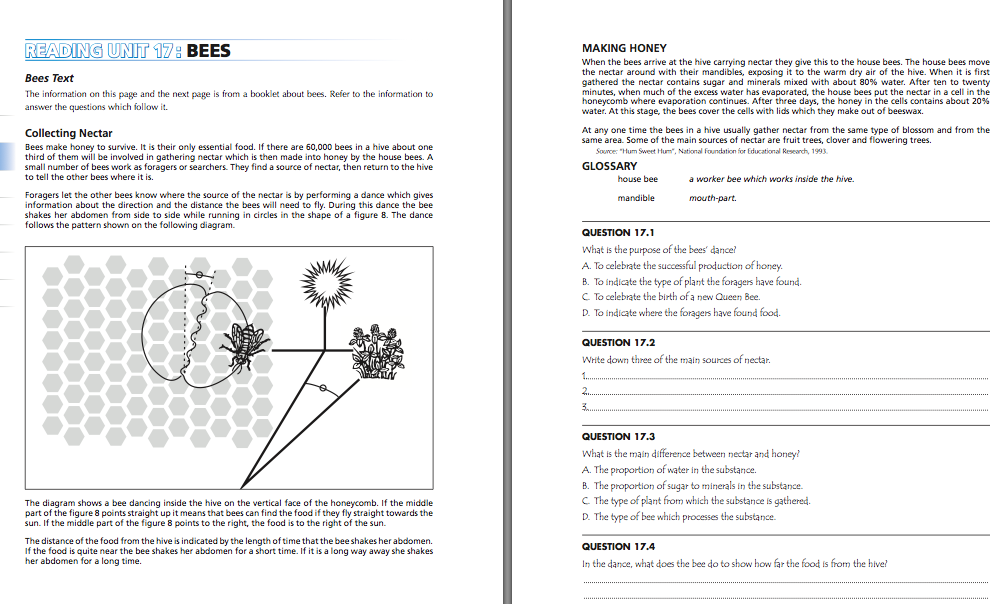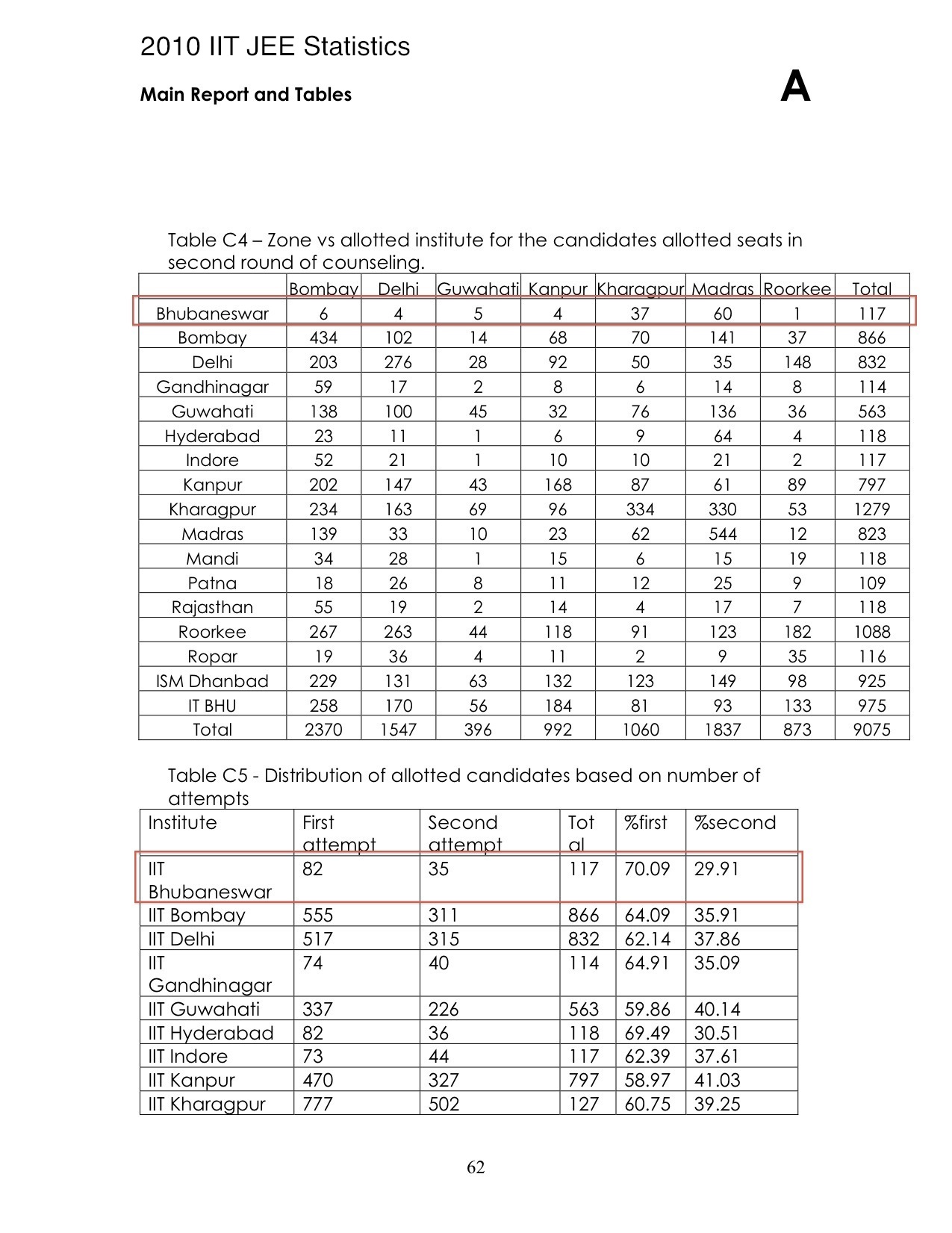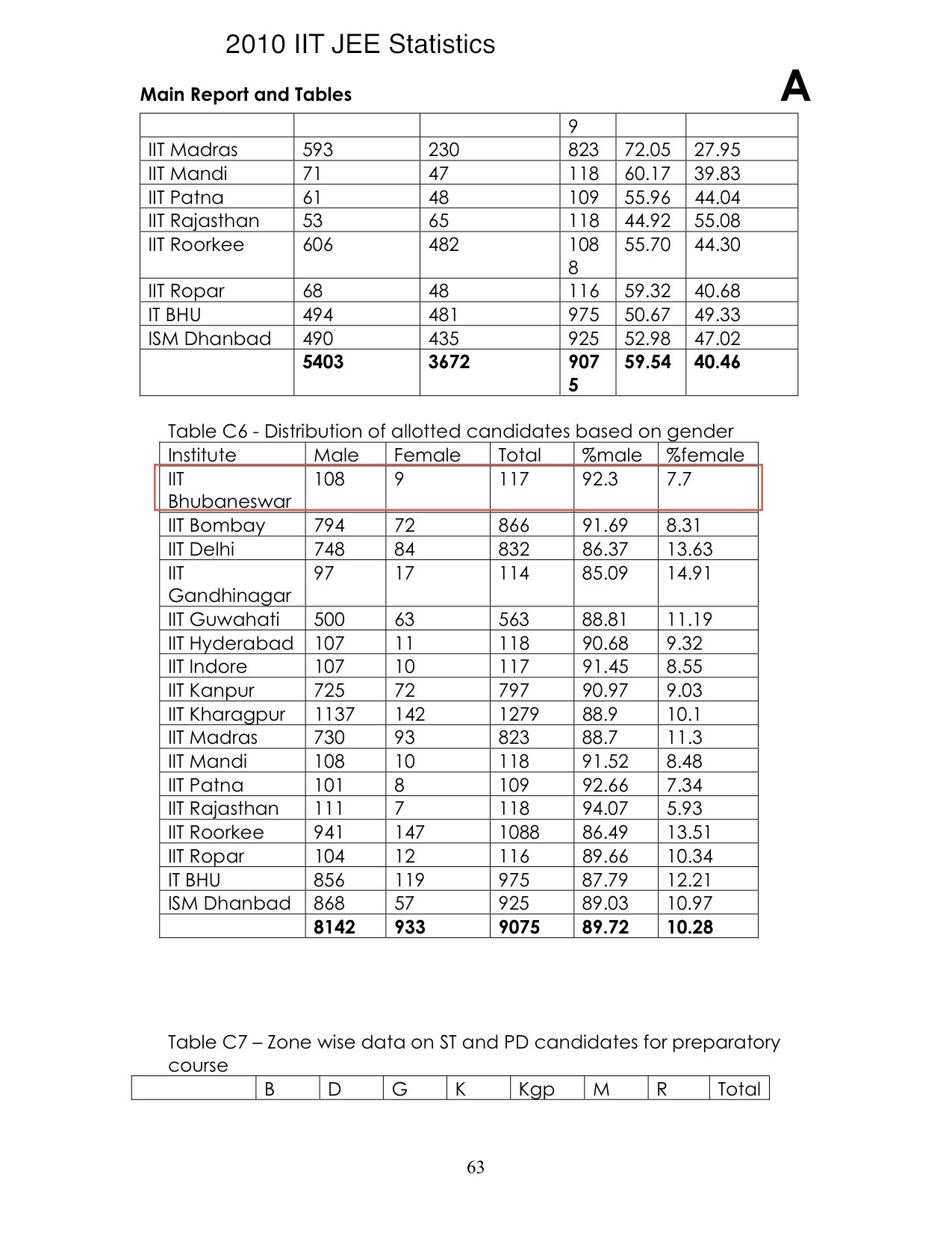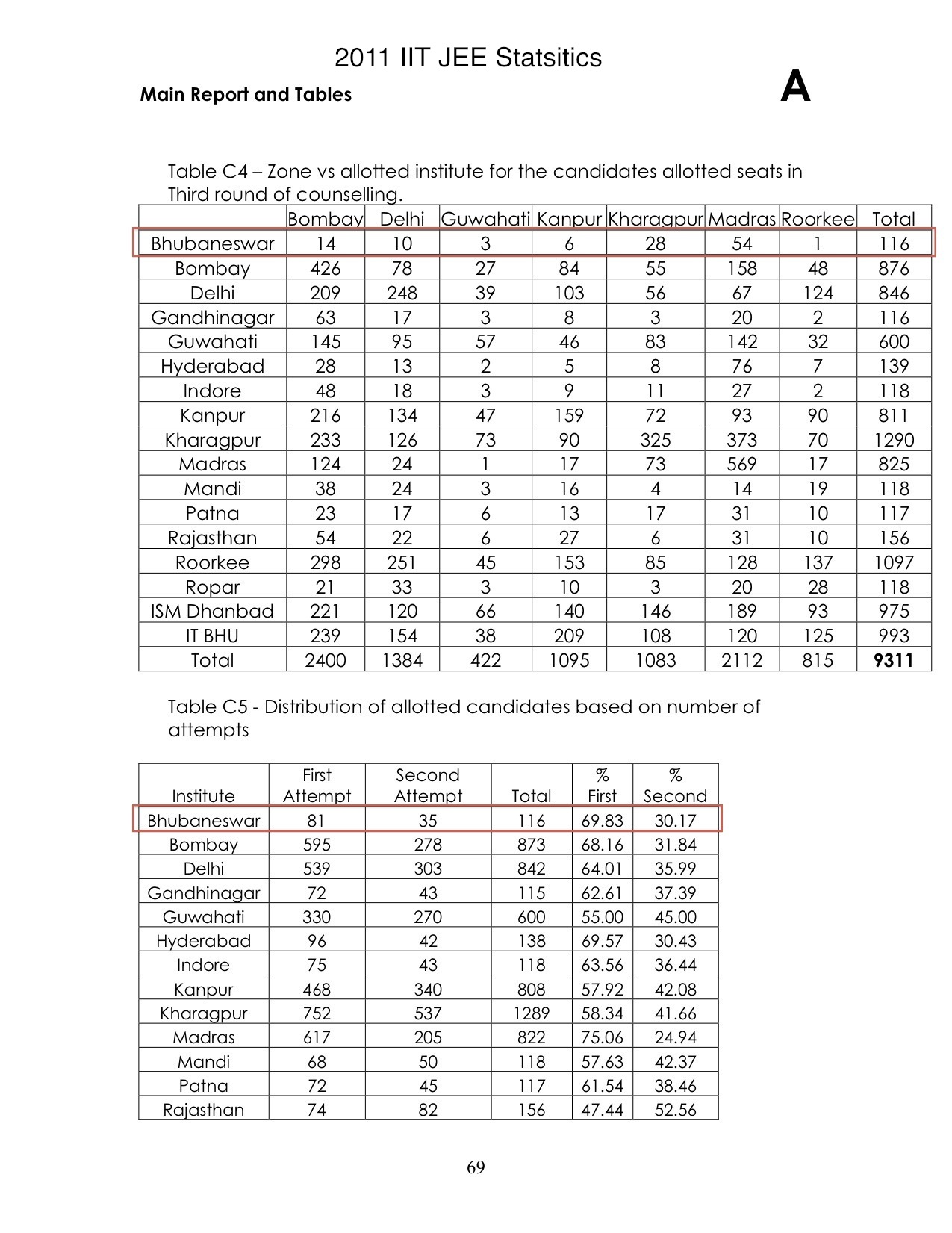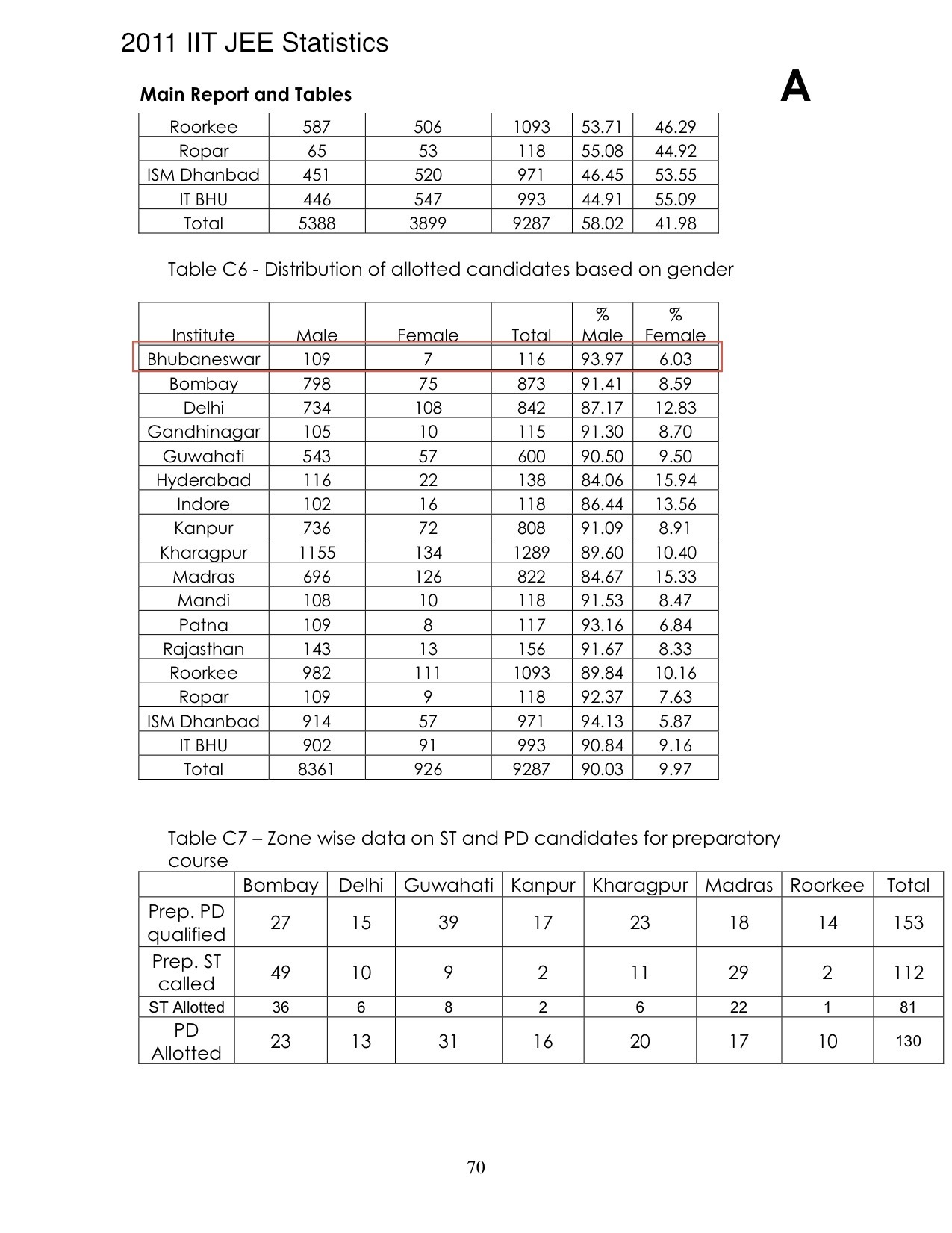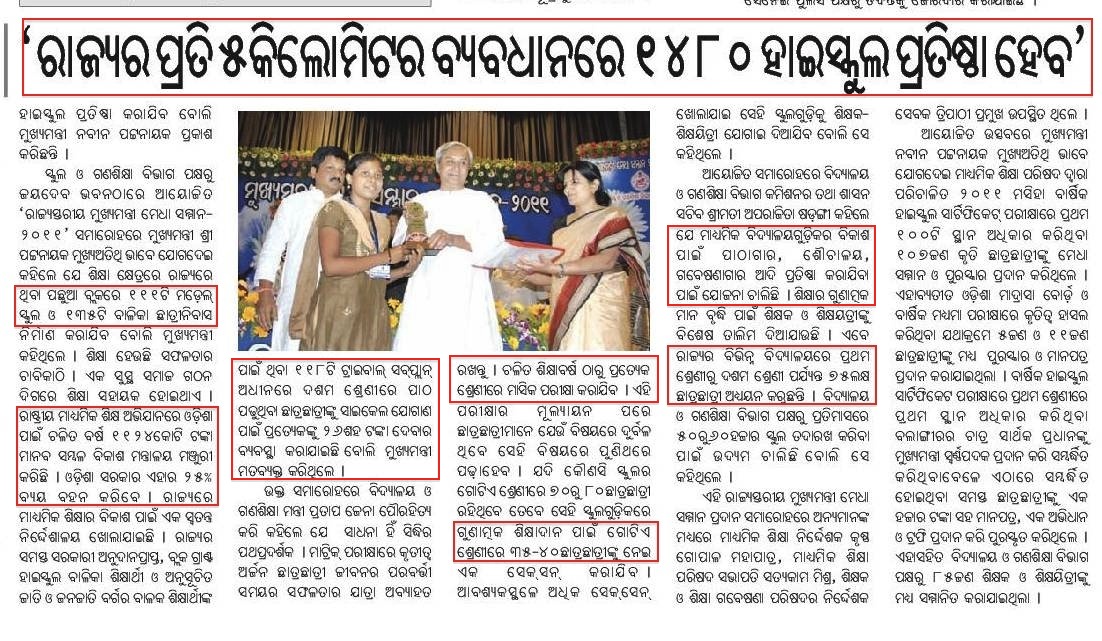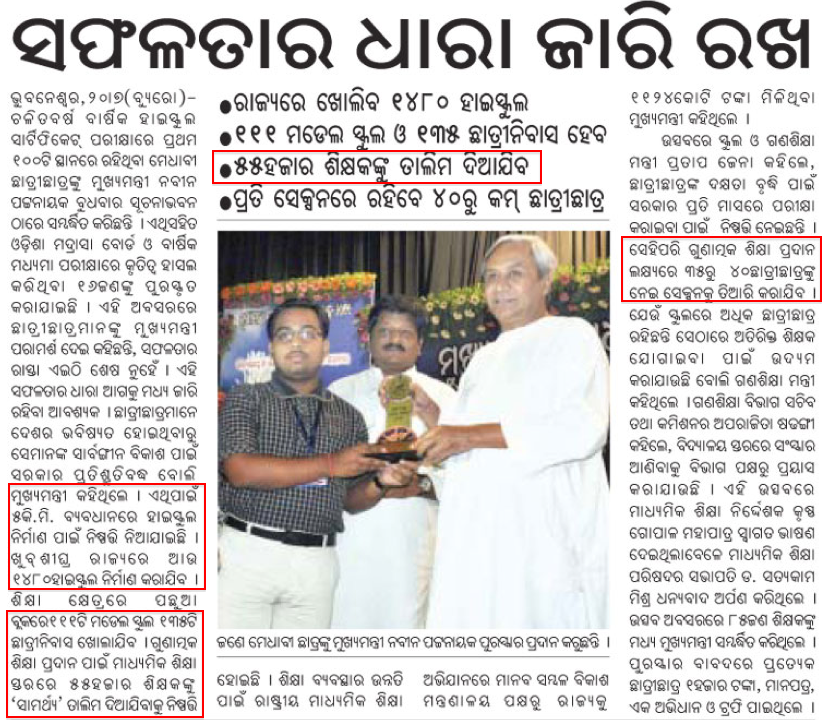Following are excerpts from a report in Pioneer.
The meeting also stressed on the need the need for increasing the student intake in these premier institutes of Science and Research and urged the IISERs to support the proposed Science Magnet Schools to attract students early in life to the realm of science.
Ten such elite residential schools first of its kind in the country have been approved by the Planning Commission. These schools would teach only science to students from Class IX onwards and will offer them opportunities to interact with top scientists.
Following are excerpts from netindia.in.
He appreciated the willingness of the IISERS to support the proposed Science Magnet Schools to attract students at their early age to the realm of science.
… Sibal also called for a good eco system in and around the IISERs through interaction with institutions located in the state. The progress made in this regard would be reviewed in the next meeting to be held sometime in June, 2012, an official press release added.
March 10th, 2012
Following is an excerpt from a report in Hindu Business Line.
The first of the global schools to be set up in Bhopal is likely to be operational by the end of this year. “We are in talks with investors for setting up schools in Kolkata, Bengaluru and Rourkela,” Mr Kumar said. The school will have classes from kindergarten to XII.
According to Mr Kumar, the primary differentiating factor between FIITJEE’s World School and Global School would be in terms of the infrastructure and curriculum.
“The world school in Hyderabad is not a residential school and is based primarily on the State board syllabus. The global school, on the other hand, will have both day scholar and boarding facilities, the infrastructure will also be of higher standards and it will offer three curriculum options (CBSE, ICSE and State board) to students to choose from,” Mr Kumar said.
The average cost of setting up the infrastructure for the Global School would be close to Rs 150 crore, he said.
February 15th, 2012
I have been thinking of this issue since December when I interacted with a niece and nephew of mine (see below). Today I came across a TOI report on Indian students being at the bottom (2nd from bottom), which made me reflect further and write this post. Following are some excerpts from that report.
Fifteen-year-old Indians who were put, for the first time, on a global stage stood second to last, only beating Kyrgyzstan when tested on their reading, math and science abilities.
India ranked second last among the 73 countries that participated in the Programme for International Student Assessment (PISA), conducted annually to evaluate education systems worldwide by the OECD (Organisation for Economic Co-operation and Development) Secretariat. The survey is based on two-hour tests that half a million students are put through.
… The states of Tamil Nadu and Himachal Pradesh, showpieces for education and development, were selected by the central government to participate in PISA, but their test results were damning.
15-yr-old Indians 200 points behind global topper
Tamil Nadu and Himachal, showpieces of India’s education and development, fared miserably at the Programme for International Student Asssment, conducted by the Organisation for Economic Co-operation and Development Secretariat.
An analysis of the performance of the two states showed:
In math, considered India’s strong point, they finished second and third to last, beating only Kyrgyzstan
When the Indian students were asked to read English text, again Tamil Nadu and Himachal Pradesh were better than only Kyrgyzstan. Girls were better than boys
The science results were the worst. Himachal Pradesh stood last, this time behind Kyrgyzstan. Tamil Nadu was slightly better and finished third from the bottom
The average 15-year-old Indian is over 200 points behind the global topper. Comparing scores, experts estimate that an Indian eighth grader is at the level of a South Korean third grader in math abilities or a second-year student from Shanghai when it comes to reading skills.
The report said: "In Himachal, 11% of students are estimated to have a proficiency in reading literacy that is at or above the baseline level needed to participate effectively and productively in life. It follows that 89% of students in Himachal are estimated to be below that baseline level."
The detailed and insightful blog posts here, here, here, here and here have more details on this PISA test and MHRD’s reaction to India’s performance.
So here are my personal thoughts on this.
As I mentioned earlier, this December I interacted with a nephew and a niece in India. This niece lives in a small town (Vyasanagar) and had 85%+ in her class ten exam and was preparing for her +2 Science exams. She was very good at solving math problems on topics that she had already learned. For some reason I asked her to read a new section in the book and solve the problems at the end of the section. She could not do it. She asked me to explain that section. Upon further inquiry I found that her studying pattern was to attend "tuition" where the tuition master would explain a particular section of a book and then give problems. In other words she was lacking in "reading comprehension". The same story with respect to my nephew, an engineering student. He could not read a section on his own and understand it well enough to solve the problems at the end of the chapter.
Considering the prevalance of "tuition" in India the above are not isolated cases. I think the "epidemic" of tuition is due to the fact that most school students in India have not developed the "reading comprehension" skills. That is because developing the "reading comprehension" is neither emphasized nor tested and this is especially true with respect to "Reading comprehension in English".
Starting from the very beginning, English text books have a series of chapters with stories, essays or poems and at the end of it there are questions with respect to them. This seemingly suggests that students using those text books are being taught "Reading comprehension in English".
That is not the case.
Most often, the teachers or the tutors read the text and explain the students those chapters. At times they may ask the students to read the text aloud. But that does not automatically develop the "reading comprehension" skills.
I am surprised that the neglect of the development of "reading comprehension" skills has not been widely noticed and acted upon. Following are pointers to some places where they have been noticed. But I am not sure they have been properly addressed.
The wonderful organization Pratham has a "Read India" program. Following is an excerpt from their main page:
Read India was therefore launched on a national scale in 2007 to help achieve the following objectives:
* All Std I children know at least alphabets & numbers.
* All Std II children can read at least words & do simple sums.
* All Std III-V children can at least read simple texts fluently & confidently solve arithmetic problems.
Later in that page they have:
In 2009-10 Read India moved to the next level, Read India II, focuses on higher grade-specific learning competencies, where basics have been achieved.2010 onwards, Read India II moved from our previously used model of short-term large-scale learning campaign mode to a longer, more sustained presence in the villages that we work in, in order to bring about a deeper more permanent impact.
However, no where in that page "Reading Comprehension" is mentioned. But by googling the phrase "Reading to Learn R2L methodologies Pratham" I was able to reach the page http://www.prathamusa.org/programs/learning-support-classes where "reading comprehension" is mentioned in the following context.
Read to learn (R2L) picks up where Learn to Read leaves off. Out-of-school children are the priority of the program. Once children have built their basic reading skills, they are taught how to read with comprehension and express what they have learned. R2L classes have two phases:
- Phase 1 (R2L1) strengthens reading, comprehension of school and other texts, and independent writing.
- Phase 2 (R2L2) ensures that the children complete the basic curriculum for Grade III as prescribed by the National Council for Education Research and Training (NCERT).
The 2006 NCERT document at http://www.ncert.nic.in/new_ncert/ncert/rightside/links/pdf/focus_group/english.pdf makes the following point.
3.5 Text Books
All this implies much more teacher and learner control over the texts used in class, including textbooks. Curricular freedom cannot exist in the presence of a single prescribed text. Earlier practices of choosing from a range of available texts can be revived; some states like Orissa have come up with innovative textbooks with short units that can be “covered” within a single class (Sunwani 2005), incorporating the idea of a reading card. Language should be seen as a “dynamic” text, i.e. exposure should be to new occurrences of comparable language samples everyday, rather than repeatedly to a single text
that is mastered (Amritavalli (1999) makes an analogy with the learning of a raga in Indian classical music). This will prepare the child for tests of “unseen” comprehension passages. Teachers and learners need to evolve for themselves a balance in the use of predictable and unpredictable texts that suits their individual levels of comfort.
But I wonder if anything has been done about it.
What needs to be done is from the very beginning "Reading comprehension" should be emphasized and tested. How? As suggested in the above mentioned NCERT document, students should be trained to read passages on their own and answer questions about them. They should be tested with respect to passages they have not seen before. This needs to happen in every class starting from the class where they learn the language.
The site http://www.nclrc.org/essentials/reading/reindex.htm makes a good case of the importance of "Reading Comprehension" and how should it be approached differently from the traditional approach. (The traditional approach is followed in India with additional drawbacks of the teachers and tutors doing the comprehension.) Following is from that page:
Teaching Reading
Traditionally, the purpose of learning to read in a language has been to have access to the literature written in that language. In language instruction, reading materials have traditionally been chosen from literary texts that represent "higher" forms of culture.
This approach assumes that students learn to read a language by studying its vocabulary, grammar, and sentence structure, not by actually reading it. In this approach, lower level learners read only sentences and paragraphs generated by textbook writers and instructors. The reading of authentic materials is limited to the works of great authors and reserved for upper level students who have developed the language skills needed to read them.
The communicative approach to language teaching has given instructors a different understanding of the role of reading in the language classroom and the types of texts that can be used in instruction. When the goal of instruction is communicative competence, everyday materials such as train schedules, newspaper articles, and travel and tourism Web sites become appropriate classroom materials, because reading them is one way communicative competence is developed. Instruction in reading and reading practice thus become essential parts of language teaching at every level.
Reading Purpose and Reading Comprehension
Reading is an activity with a purpose. A person may read in order to gain information or verify existing knowledge, or in order to critique a writer’s ideas or writing style. A person may also read for enjoyment, or to enhance knowledge of the language being read. The purpose(s) for reading guide the reader’s selection of texts.
The purpose for reading also determines the appropriate approach to reading comprehension. A person who needs to know whether she can afford to eat at a particular restaurant needs to comprehend the pricing information provided on the menu, but does not need to recognize the name of every appetizer listed. A person reading poetry for enjoyment needs to recognize the words the poet uses and the ways they are put together, but does not need to identify main idea and supporting details. However, a person using a scientific article to support an opinion needs to know the vocabulary that is used, understand the facts and cause-effect sequences that are presented, and recognize ideas that are presented as hypotheses and givens.
Reading research shows that good readers
- Read extensively
- Integrate information in the text with existing knowledge
- Have a flexible reading style, depending on what they are reading
- Are motivated
- Rely on different skills interacting: perceptual processing, phonemic processing, recall
- Read for a purpose; reading serves a function
Reading as a Process
Reading is an interactive process that goes on between the reader and the text, resulting in comprehension. The text presents letters, words, sentences, and paragraphs that encode meaning. The reader uses knowledge, skills, and strategies to determine what that meaning is.
Reader knowledge, skills, and strategies include
- Linguistic competence: the ability to recognize the elements of the writing system; knowledge of vocabulary; knowledge of how words are structured into sentences
- Discourse competence: knowledge of discourse markers and how they connect parts of the text to one another
- Sociolinguistic competence: knowledge about different types of texts and their usual structure and content
- Strategic competence: the ability to use top-down strategies (see Strategies for Developing Reading Skills for descriptions), as well as knowledge of the language (a bottom-up strategy)
The purpose(s) for reading and the type of text determine the specific knowledge, skills, and strategies that readers need to apply to achieve comprehension. Reading comprehension is thus much more than decoding. Reading comprehension results when the reader knows which skills and strategies are appropriate for the type of text, and understands how to apply them to accomplish the reading purpose.
Section Contents
Goals and Techniques for Teaching Reading
Strategies for Developing Reading Skills
Developing Reading Activities
Using Textbook Reading Activities
Assessing Reading Proficiency
Resources
One should read the above pointers to get the whole picture of how to do it right.
January 15th, 2012
An article in Telegraph mentions that Sainik School Bhubaneswar occupies an area of 220 acres. It is located next to Utkal University in a prime location. At present the Bhubaneswar Sainik School has a capacity of 525 students. Its current faculty strength is 28 and it has an adminsitrative staff of 14. It probably has some more maintenance staff.
While the achievement of Sainik School Bhubaneswar has been very good (see excerpt below)
Achievements: So far approximately 600 cadets have become officers in the defence forces through NDA alone. In addition many cadets have got commission through other entries. This school also has been honoured by the achievements of its cadets through various civil services like IAS-14, IPS-07 and allied services – 09. Several have become ministers in the State of Orissa and Nagaland. The cadets making foray in the fields of medical, engineering, merchant navy are plenty and doing the school proud. The highest ranking officers are two major generals and one Air Vice Marshal.
I think the 220 acres in a prime location in a capital city is a gross under utilization of the land for a residential school of 525 students, 28 teachers and 14 academic staffs, unless one explains it away as a green cover.
Following excerpts tell the story of how the Sainik Schools were set up.
Salient Features of Sainik Schools
(a) The entire capital expenditure on land and buildings is met by the respective State Govts who are also required to provide funds for maintenance of infrastructure and for new infrastructural projects. The State Govts also award scholarships on merit cum means basis.
…
Role of Ministry of Defence in Sainik Schools
(a) Ministry of Defence provides scholarships to wards of defence personnel including ex-servicemen. In addition Ministry of Defence provides central assistance to those students who are awarded state scholarships. The sharing of expenditure on fees/scholarships among Central Govt, State Govt and parents is decided by the BOG from time to time.
(b) With effect from financial year 2003-04, the Ministry of Defence has implemented a scheme under which burden of fee and dietary charges are being shared between the Ministry of Defence and the parents in the ratio 3 : 1. Under this scheme all boys studying in Sainik Schools get financial assistance of about Rs.9,000 – 10,000 every year. The scheme also provides incentive to boys who join the NDA by refunding.
Achievements of Sainik Schools a) Aims – So far these schools have contributed about 7,000 officers to the three services. Its students today occupy important positions in all spheres of national activities. Since the schools were founded in early 60s, its cadets have now reached the level of Generals in the Army and equivalent Ranks in the Navy and Air Force.
b) Results – These schools send about 130-160 cadets to the NDA every year. As far as CBSE results are concerned the schools are performing creditably. All efforts are on to improve the results qualitatively.
c) Quality Education – In most of the States Sainik Schools are the only residential institutions and that too located in isolated areas. Thus these schools have been able to contribute significantly to development of education in backward areas and also in carrying out backward area educational integration.
Considering that the state government gave the land and buildings to the school and in most states these schools are in isolated areas, I think it may be worth pondering if the:
(a) Sainik School Bhubaneswar should be relocated to a backward area where it can contribute positively to the area and the existing 220 acres be used more productively; perhaps by turning it to a small Knowledge City, say similar to the 381 acres Knowledeg City in Mohali.
OR
(b) augment the current use by using part of the 220 acres of Sainik School Bhubaneswar to establish a military academy or an armed forces medical school or a DRDO lab, etc. to have better land utilization.
There are many examples similar to (b). For example, IISER Pune is established on NCL (National Chemical Laboratory) land.
This may be a good time to ponder about options (a) and (b) as it is reported that:
The 220-acres of land given by the government for the existing Sainik School in Bhubaneswar established in 1962 continues to be under the general administration department of the government.
December 16th, 2011
Following is an excerpt from a report in Times of India.
… Kendriya Vidyalay Sangathan (KVS) has decided to set up a Zonal Institute of Education and Training (ZIET) in Bhubaneswar. This will be the fifth such institute in the country and will cater to over 350 schools of eastern region as a resource centre for states like Bihar, West Bengal, Orissa, Jharkhand and the northeast states.
"Earlier we had to depend on other ZIETs for the purpose of conducting in-service training, refresher courses, workshop and induction courses and research activities. The ZIET in Bhubaneswar will cater to the need of not only teaching but also non-teaching staff of schools. Besides, it will also help in preparation of model lessons and study material, to plan and propose the new areas and strategies required to be incorporated during the training programme to improve the quality of education," said principal of Kendriya Vidyalaya-1, S K Behura.
The ZIET will temporarily function from KV-I till its own building will be constructed in its permanent KVS building at Bankuala, on the outskirts of the city, Behura said.
ZIET, an autonomous body under the ministry of HRD, would also ensure that the participants are provided training in the areas of subject expertise, communication skills, classroom transaction skills, evaluation skills and student-development skills. It also aims at promoting a positive work culture and attitude among teachers through training and develop a healthy attitude in teachers towards research in school education. …
"Initially ZIET will provide training to KVS staff but later will also help in capacity building of employees of all CBSE schools in the region," Behura added.
The web sites of the existing ZIET are as follows:
September 28th, 2011
Following are excerpts from http://educationworldonline.net/index.php/page-article-choice-more-id-2862.
Among other primary-secondaries which have improved their public image and zoomed into the list of India’s Top 30 day schools are the formerly unranked Mirambika, Delhi (27), DAV, Chandrasekharpur, Bhubaneswar (28) and Bombay International (29).
… Thus further investigation of the national league table reveals that Gitanjali School, Hyderabad (estb.1985) is the No. 1 day school in Hyderabad and the southern state of Andhra Pradesh (pop.85 million), no mean achievement. Likewise the Riverside School, ranked a modest No. 13 nationally is the No. 1 day school of Ahmedabad and the western seaboard state of Gujarat (pop. 60 million); DAV, Chandrasekharpur is the No. 1 day school of Orissa (pop. 42 million); St. John’s High is No.1 in Punjab, and City Montessori, Gomti Nagar, ranked No.50 nationally is Lucknow’s most respected day school and fifth in Uttar Pradesh — India’s most populous state (200 million).
The following article from Sambada mentions couple of other schools from Odisha that are ranked high in the eastern zone. The eastern zone ranked schools are: DAV Chandrasekharpur (2), DAV Bhubaneswar (9), DPS Kalinga (17) and KIIT international school (20).
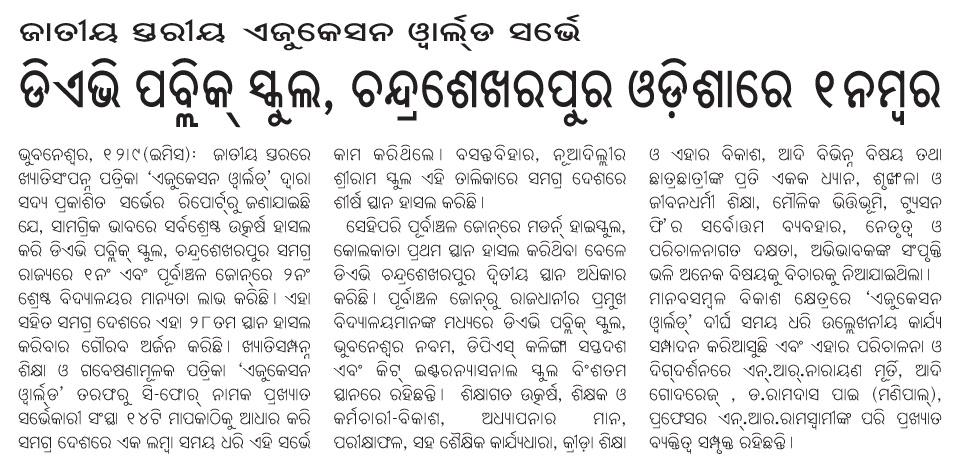
September 13th, 2011
Following is from a report in ibnlive.com.
The State Government is planning to start open schools in all the districts very soon to enable over-aged dropouts complete their schooling.
The initiative is being taken under the Orissa State Open School (OSOS) which proposes to set up the open schools on the lines of the National Institute of Open Schooling (NIOS). Students getting themselves enrolled at the open school could either opt for a personal contact programme or a distance education programme to get quality education. For the junior classes, the school would impart education in essential subjects, including arithmetic, reading and writing, alongside pre-vocational training to help them get employment in case they are unable to continue their education. These schools will also offer dozens of new courses so that students can opt for the professional skills best suited to their regional markets.
“The idea has been mooted with an aim of drawing school dropouts back to classrooms by providing them an organised system of education outside of formal schooling,” said School and Mass Education Minister Pratap Jena while speaking to this paper.
He said talks are on with the higher authorities of NIOS to formulate the courses and schooling designs and the Department is expecting to start the open schools during the ongoing academic year. “The open schools are expected to draw a large number of dropouts in the State who want to complete their schooling. The duration of the courses for classes V, VII and X would be of six months each. The detailed modalities for the functioning of these schools are being worked out,” the Minister said. He added that extra care will be taken to ensure that quality of education in such schools is not compromised. The schools would function through a number of study centres which would be established in different districts.
Several other state governments have launched the open-school system to provide educational facilities to over-aged school dropouts to complete their education.
The website of the NIOS is http://nos.org/. Currently one of its 16 regional offices is in Bhubaneswar. Its contact details is:
Sh. Rushi Kumar Rath
Regional Director, Regional Centre – Bhubaneswar ,
Adivasi Exhibition Ground Unit 1, Bhubneswar -751 009, Orissa
Ph: 0674-2740208, Fax : 0674-2597287, E-mail:rcbbsr@nios.ac.in
July 11th, 2011
The web page of Orissa Model Tribal Education Society (OMTES) is http://www.omtes.org. Following are excerpts from its "Background" page.
The Orissa Model Tribal Education Society (OMTES), a registered Society supported by the ST & SC Development Department, aims to make positive interventions in the field of tribal education. Since its inception in March 2000, it has been instrumental in setting up 11 Ekalabya Model Residential Schools in different parts of the State with assistance from Government of India. Besides that it also manages 19 Educational Complexes set up for providing education to ST Girls belonging to Primitive Tribal Groups. OMTES continues in its endeavour to serve the tribal population of the State by ensuring them to avail best opportunities in education at par with the non tribal population.
Following are some Q & A from its FAQ page.
How the schools are managed at the district level?
A school level management committee headed by the Collector of the respective districts, members including two educationist of the area looks after the overall development of the schools. Here the collector is the chairman and concerned Principal of ERMS is the Member Secretary.
I am a Tribal, what is the benefit the society has for me?
You benefit, when your child qualifies entrance of the school and receives free qualitative education. The society provides for improving the quality of tribal by promoting educational schemes for tribal community and improves the quality of life of tribal by Ashram Schools, Hostels for Tribal Boys Educational complexes, Post- Matric Scholarships and Book Bank Schemes, etc.
Whom do I contact for more information?
For information you are requested to contact ST & SC Development, Govt. of Orissa.
The 11 schools are listed in the page http://www.omtes.org/Yearwise_establishment_EMRS.html. They are in the districts of Koraput, Mayurbhanj, Sundergarh (3), Rayagada, Koenjhar, Gajapati, Kandhamal, Nabarangpur, and Jajpur.
The 19 educational complexes are listed in the page http://www.omtes.org/Yearwise_establishment.html. They are in the districts of Keonjhar (3), Rayagada (2), Nuapara, Mayurbhanj (2), Deogarh, Angul, Kalahandi, Ganjam, Gajapati (3), Malkangiri (2), Sundergarh and Kandhamala. Each of these complexes have a capacity of 250 making a total capacity of 4750.
In contrast, as of today, KISS has a student body of 15,083, which includes 3553 students pursuing +3. KISS had a student body of 1500 in 2005. I am sure the performance of the students is better at KISS than of the students at the OMTES schools and educational complexes.
So the Odisha government should just give land, seed money and grants to KISS and let them establish and manage much larger facilities in the districts with significant tribal students.
In http://www.kiss.ac.in/admission.html it is mentioned that every year KISS gets 30,000 to 40,000 applications per year for admission and admits between 2000-3000 of them. The government should fund KISS so that if not all who apply are admitted at least half of them are admitted.
It is a pity that other states have taken note of KISS and are inviting KISS to open replicas in their states while Odisha does not seem to be taking similar steps. Following is an excerpt from a report in Pioneer on other states approaching KISS for replicas.
A branch of the Kalinga Institute of Social Sciences (KISS) has been set up in Bastar, a tribal dominated and Maoist infested region of Chhattisgarh with assistance from the National Mineral Development Corporation (NMDC).
An MoU to this effect was signed between the KIIT and the KISS founder Dr Achyuta Samanta and NMDC director GB Joshi in the presence of the NMDC chairman cum managing director Rana Som at the the latter’s Corporate Office in Hyderabad on June 24.
As per the agreement, the NMDC has provided 30 acres of land along with all financial assistance to the KISS in order to set up its replica in Kankar region of north Bastar district in Chhattisgarh. In the first phase, 1000 tribal boys and girls will be admitted in this school. However, a total of 4,000 students from five districts in and around Bastar will get the opportunity of quality education here in course of time.
After Bastar, the Governments of Jharkhand, Madhya Pradesh and Delhi are keen to set up such model schools bearing all financial implications. They have requested Dr Samanta accordingly.
The page http://www.kiss.ac.in/fmngt.html explains how KISS is funded. The total amount there adds up to 18 crores. If 10 such KISS replicas are established in 10 tribal districts of Odisha at an additional cost of 200 crores/year, that will be the best use of such money for Odisha.
July 8th, 2011
Following is from a report in Times of India.
… In the last few years, nearly 125 private Plus-II science colleges have mushroomed in and around the city. Lured by their promise of helping students to crack the IIT entrance and other tough competitive exams, parents are ready to cough up whatever admission amount and fees they ask for.
… These completely residential colleges offer reasonably good infrastructure and a host of extra facilities like coaching for competitive exams, 24×7 teachers` guidance, Wi-Fi campus, air-conditioned classrooms, comfortable hostels and transportation services. The facilities, obviously, come at a price — these institutes charge at least 10 times more than government-run colleges.
"The reason for proliferation of self-financing colleges in the city is the lack of infrastructure, good teaching and extra facilities in government colleges. Students of state colleges have to depend on tuitions after college hours to complete their course; as a result, they don`t get much time for self-study. But in private residential colleges, they get enough time to study on their own," said Biranchi Panda, the president of Jupiter +2 Science College.
The principal of BJB Junior College, S N Mohanty, said, "New educational institutes are always welcome if their genuine purpose is to impart education. But most of these colleges are shops out to rake in profits. They are commercial establishments rather than educational institutes. Besides, there should be a law to regulate the fee structure and the profits of these colleges."
The fee for the two-year Plus-II course in self-financing, residential colleges ranges between Rs 75,000 a year to Rs 1.40 lakh a year, depending on the infrastructure and facilities. "It`s burning a hole in my pocket to pay the fees of my two daughters studying in two different residential colleges in the city. Before admission, these institutes make many promises but once the students join they realize they lack many things," said Prafulla Rout of Barbil.
Padmaja Naidu, the director of Naidu +2 Science College, said, "If you take the fee of a government college along with entrance exam coaching fees, it will be equal with the expense of studying in a private college. Parents want air-conditioned classrooms and refrigerators in hostels. And these facilities do not come for free."
However, many feel it is high time to run checks on self-financing colleges in the city. Many of these institutes are operating out of rented houses without quality teachers, laboratories, libraries and other infrastructure. Following allegations of manipulation of results at a well-known self-financing college, the government ordered a crime branch probe.
"The mushrooming of self-financing colleges is mainly due to the faulty policy of the state government. There must be checks in place at some point. The government is giving approval to colleges without properly verifying infrastructure and faculty positions. Due to this, many government colleges are suffering," said the principal of Newton +2 Science College, K C Mohanty.
R N Panda, the principal of Institute of Higher Secondary Education, said, "There are many genuine private colleges that are run by academicians although some of them are luring students with false promises. Private colleges have accountability and a healthy competition, which government institutes lack."
May 23rd, 2011
The web page of this contest is at http://settlement.arc.nasa.gov/Contest/. The results of the 2011 page is at http://settlement.arc.nasa.gov/Contest/Results/2011/index.html. Following are excerpts from that web page.
Winners
Grand Prize
The Grand Prize for the 2011 Space Settlement Contest went to a large team of 7 students (11-12 grade), Gaurav Kumar, Deepak Talwar, Harman Jot Singh Walia, Mahiyal B. Singh, Kaenat Seth, Ishaan Mehta, and Navdeep Singh Makkar, from Punjab, India for creating the Hyperion Space Settlement. They also won the NSS Bruce M. Clark, Jr. Memorial Space Settlement Award.
First Prize
11-12 Grade First Prize
- Asteria, Sarah Bell, Queensland, Australia, Individual.
- Shangri-la, Odisha, India (Delhi Public School), Small Team.
- CRONOS, Constanta, Romania (Colegiul National "Mircea cel Batran"), Large Team.
9-10 Grade First Prize
- Adamas, Aditya Bathla, Punjab, India (Apeejay School), Individual.
- AMOS (Advanced Moon Orbiting Settlement), Romania ("Tudor Vianu" National High School of Computer Science), Small Team.
- Brisinger, Constanta, Romania (Colegiul National "Mircea cel Batran"), Large Team.
6-8 Grade First Prize
- The Satus Novo Serere, Hasan N. Kahn, Riyadh, Saudi Arabia (American International School), Individual.
- Big Bang, California, USA (Sequoia Middle School), Small Team.
- EON: Everlasting Orbita Nation, New York, USA (Cortland Junior Senior High School), Large Team.
Specialty First Prize
- S’ukhavati, Mrinal Chaudhury, Odisha, India (Delhi Public School), Artistic Merit.
- Life on the Space Station, Seebor, Romania (Tudor Vianu National High School of Computer Science), Literary Merit.
- Arcadia, Shanghai, China, Life Sciences.
Rourkelacity.com has some details about the winners. Following are some excerpts.
Among the winners include the team comprising Siddharth Tripathi, Akshat Dutt and Nisarg Behera of class –XII, and Mrinal Chaudhary of class-VIII of the same school.
The team comprising Siddharth, Akshat and Nisarg won the first prize in the 11th -12th grade for their project titled “Sangri-La”, a space settlement colony to provide exceedingly proficient and enjoyable living amenities for 20,000 permanent space residents. The colony that the team has proposed, is designed as a heavenly abode for settlers who can revel in the extraordinary luxury away from the earth. Thinking out of the box, the team proposed a major scientific research laboratory as well as a business hub in space, bio-regenerative life systems incorporating all biological components, state of art meditation halls, an efficiently functioning government machinery to take care of the law and order, a new currency named ‘Hawking’ and also a National Shangri-La Stock Exchange to help people participate in World economic affairs.
Mrinal won the specialty first prize for Artistic merit in her paper presentation titled “Sukhavati”. Mrinal in her report presented the colony and several paintings and diagrams depicting the interior and the exterior, living spaces, laboratories, recreation areas etc. of the colony.
… Mr.Bijoy Bahadur Mathur, Science Head of the School and the mentor to these students has been instrumental in preparing the students for this competition.
Teams from Odisha have been doing very well in this contest for the last several years.
April 26th, 2011
Following is an excerpt from a report on Times of India regarding increase in the number of students appearing in IIT JEE from Odisha.
The number of IIT aspirants in Orissa saw a steady rise with nearly 40,000 students appearing for the joint entrance examination ( JEE) for the country’s premier institute on Sunday, officials said.
Registrar of IIT-Bhubaneswar Bata Kishore Ray said, "The number of aspirants from Orissa has gone up in the last couple of years, especially after IIT-B started operating from the city. …
… About 30,000 aspirants appeared from the state last year, he added.
… In the capital city alone, over 5,000 students appeared in 12 centres for one of the toughest competitive examinations in the country.
… Director of a city-based coaching centre Jyoti Ranjan Tripathy said good coaching facilities and number of successful students increasing every year has been motivating others to go for IIT. "In terms of coaching facilities, Bhubaneswar can be called the Kota of eastern India. Orissa has created some top rankers in IIT-JEE in the last few years and this has motivated more students."
As per a report in Economic Times, the total number of applicants for IIT JEE is 4,85,262.
Following is obtained from a Deccan Chronicle report, a TOI report and another TOI report:
- Total: 4,85,262 out of which 1,13,942 were girl applicants.
- SC – 47,479; ST – 19,305; OBC – 1,42,387 (TOI)
- Madras zone (Tamil Nadu, Andhra Pradesh, Karnataka and Kerala): about 68,500 out of which 20,546 were girls. (last year 65,650)
- Mumbai zone: about 85,260/68,735*
- Kanpur zone: around 80,400/63,661* (16,770 girls)
- Guwahati zone (Arunachal Pradesh, Assam, Bihar, Manipur, Meghalaya and West Bengal): about 58,700.
- Kharagpur zone:??
- Delhi Zone: 71,353 (16,877 girls)
- Roorkee Zone: 16,976 girls
* Two newspapers give different numbers.
Assuming the numbers for Odisha are correct, it is a significant development in that 8.25% of the total applicants will be from Odisha. Note that Odisha’s population is 3.47% of the total population of the country.
Ofcourse, a more important aspect is the success in the exam, but significant increase in the applications is a good starting point. Some of the reason behind this increase are:
- More awareness due to IIT Bhubaneswar.
- The significant increase in the availability of coaching, including many nationally known coaching institutes opening their centers in Odisha, especially in Bhubaneswar. These include Careerpoint, FIITJEE, Narayana, Resonance and Vidya Mandir.
- The significant increase in the number of private +2 colleges across the state, some of which have ties with coaching classes.
Now lets hope a good number from Odisha succeed in IIT JEE. Currently Hyderabad and Kota are the places with the highest number of successful candidates. Following is an excerpt from a TOI report on that.
If JEE-2010 results are pored over, the maximum number of candidates to clear the exam was from Andhra Pradesh (AP).
The state dominated the merit list. Seven of the top ten rankers were from there, the share of Kota (which is in Rajasthan) starting only after rank 15. While in 2006, 938 candidates from AP and 1,004 from Rajasthan made it to the IITs, a year later the tables had turned, with 1,384 from AP clearing JEE and 1,344 from Rajasthan. It has been a close race since. In 2009, for example, 1,862 students from AP and 1,898 from Rajasthan cleared JEE.
There are reports from other cities and states, but many have contradictory reports. Following are data from some of these reports.
- Karnataka: 5,400 (Expressbuzz)
- Bangalore: 4,125 (Expressbuzz)
- Nagpur: 4,800 (TOI)
- Mumbai: 8,500 (DNA)
- Maharashtra: 21,000 (DNA), 21,700 (DNA)
- Lucknow: 15,000 (TOI)
- Varanasi: 8,000 (TOI)
- UP: 83,139 (TOI)
- Jaipur: 38,000 (TOI)
- Delhi: 37,411 (TOI
- Andhra Pradesh: 50,000 (Deccan Chronicle), Over 1 lakh (TOI).
- Chennai: 5,000 (Expressbuzz), 5,329 (TOI)
- Bhubaneswar: 5,000 (Times of India)
- Odisha: 40,000 (Times of India) [I doubt this number.]
April 11th, 2011
